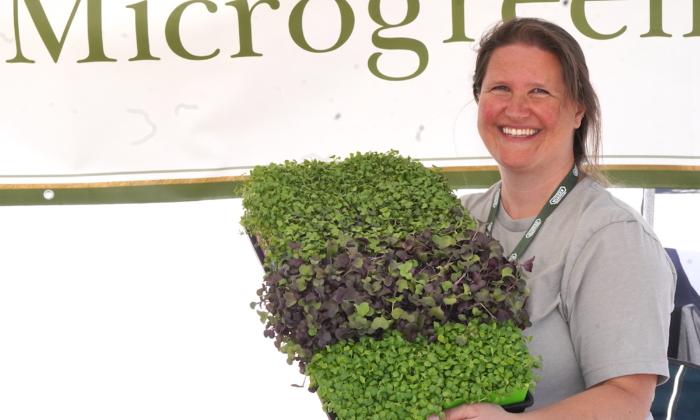COEUR d'ALENE, Idaho—Fifth-generation homesteader Melissa Norris had been growing gardens and preserving food years before COVID-19.
But the pandemic, with its unprecedented run on supermarkets, food shortages, and supply chain issues, made her decide to up her game like never before.
“I‘d been doing it for a long time before the pandemic. But I think the pandemic made me more serious about how I was doing things and planning more,” said Norris, co-founder of The Modern Homesteading Conference in Coeur d’Alene, Idaho.
On July 1, the conference was on its second day, as Norris shared a wealth of homesteader knowledge before a standing-room audience.

Norris’s topic was strategic gardening—how to grow a year’s food supply for the entire family.
The first rule of green thumb is to devise a practical gardening strategy and weed out the unnecessary.
If nobody likes them, “Why did I need five rows of Swiss Chard?” Norris asked.
You Are What You Eat
In another building at the Kootenai County Fairgrounds, Ashlee Rowland, founder of Simplholistic, spoke on the importance of saturated fats for women’s hormones and health.“If you’re not eating enough cholesterol, oddly enough, you will have high cholesterol,” Rowland said.
It may seem counterintuitive, but Vitamin D supplements also raise cholesterol levels.
“What happens when you supplement Vitamin D is your body is no longer synthesizing the cholesterol to make Vitamin D from the sun,” Rowland said.
“That’s important to note. Yes, many Americans are deficient in Vitamin D because we don’t spend enough time outside. But, for the population that does spend time outside, the liver stores enough Vitamin D throughout the summer to have you on a drip the entire winter.”
“If you are getting adequate sunshine, peered with red light, as we should, in the spring, summer, and fall, in winter, we don’t need to supplement Vitamin D.”

Those who consume bottled water are drinking “thirsty water,” she said.
“You’re dehydrating yourself more every time you take a drink. That’s because the bottling process strips the minerals from the water,” Rowland said.
“If you’re not adding minerals to the water, you dehydrate yourself with every drink. As it goes down your body, it’s pulling minerals from every cell.”
Coconut water, loaded with micronutrients, is a good substitute for bottled water. Not only that, but using a mineralization filter, drinking spring water, or steeping water in sun teas or “solar infusions.”
Then there are weeds.
“There are so many medicinal herbs growing all around us, known as weeds,” Rowland said.
“Put them in water, put them in the sun. Don’t fear what the FDA says about bacteria growing underwater in the sun. People have done this since the beginning of time.”
The two-day conference also had more than 70 vendors selling homesteading products and sharing homegrown wisdom on becoming less reliant on the system.

Gretchen, who did not want her surname used, is the owner of Happy Homestead and worked with visitors one-on-one explaining the fantastic nutrition and health benefits of micro-greens.
Micro-greens are plants in the second stage of their development after sprouting, packed with vitamins and minerals, and bursting with flavor.
Gretchen explained that micro-greens contain 40 times more nutrition than fully-grown herbs and plants.
“It’s a nice power pack of nutrients in a small amount. You can add them to anything.”
Gretchen displayed grow boxes with clover, radishes, and broccoli to demonstrate. Easy to grow, they keep for days, taste great, and can go with almost any food.
Going Micro-Green
“I put them in everything. They go great with anything.”Broccoli micro-greens contain many nutrients that may prevent certain types of cancer.
Gretchen began Happy Homestead last October, realizing a quick learning curve. She advises anyone can grow their micro-greens, given their short harvest times.
She recommends using kits with organic, non-GMO plants. She said you can also find micro-greens in most grocery stores and farmers’ markets.
“They’re popular. What’s driving it in the most general of terms is mostly health. Health and sustainability are big issues for people. That’s the most common thing I hear from people talking about it,” Gretchen said.
At another booth, Nate Kromer, senior brand manager of Nick’s Handmade Boots, showcased a range of all-leather footwear.
Based in Spokane Valley, Washington, Kromer said the company has been “keeping it alive” by making handmade leather footwear since 1964.

Kromer said all materials used in manufacturing are from leather suppliers and tanneries in the United States.
The difference compared with imports is one of quality, he said. Footwear made in China may often contain synthetics such as carpet padding, plastic, and even paper—which wear out quickly.
A shoe or boot made of pure leather can last years or decades. “It depends on the person, on how long someone takes care of it,” Kromer told The Epoch Times.
“Definitely [it will last] over a decade out for a pair of boots with some repairs and resoles. If you take care of them, they last quite a while.”
“A lot of people run them out. It eventually pays off.”
Norris said turnout at the inaugural modern homesteading conference exceeded her expectations and those of co-founder and homesteader Katie Millhorn.
One online ticket count showed more than 3,600 visitors, but Norris said the final tally was around 4,500.
“It’s amazing. We are excited and thrilled to see so many people. It’s phenomenal.”
“A lot of it is to learn [and] the opportunity to learn from experienced people. It’s the in-person aspect,” Norris told The Epoch Times.
“It’s also the community aspect of visiting one another. You’re standing in line, talking with someone, and building those relationships.”
With like-minded people, “You understand this. I don’t have to explain myself to you. You get it. Your soul is full.”
Norris said the 2020 pandemic was the catalyst for people thinking about homesteading to implement their plans.
“They looked at this and realized how fragile our food system is.”

On day two of the conference, other topics included growing crops by working with other farms, time management for homesteaders, building a community like the Amish, and knowing what’s in your food.
Angela Palmer of southern Idaho said Norris’s presentation on food preservation was on her “must-see list.”
Food For Thought
As a general rule, Norris said homesteaders should only plant what they know they will eat and “get serious” about raising a year’s worth of food.That means documenting how much the family consumes each item, whether vegetables, herbs, or fruits, on average for a month.
Then, determine how much everyone eats several times a week to narrow down the list of top candidates for the home garden.
Norris said it’s also crucial to know the local climate to know which crops will grow best, learn to adapt strategies, and which product is best for preserving.
Most importantly, she said never to raise crops that don’t grow in the immediate environment.
“We just need to give crops what they need to grow, and they'll do the work for us,” Norris said.
“Where I live, I cannot grow ochre or sweet potatoes. Tomatoes are worth it for me. I’m going to start those babies because I’m not willing to not have tomatoes in our diet.”





